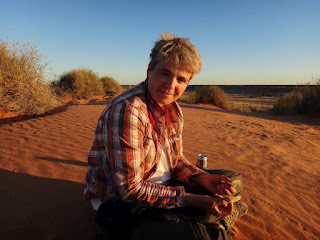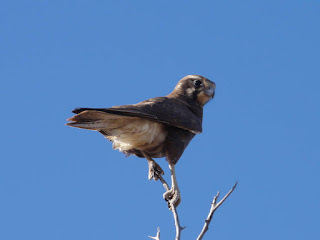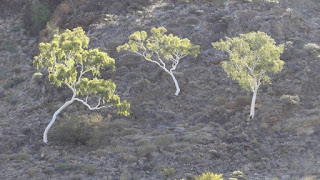We did it!! We crossed the Simpson Desert with over 1100 sand dunes. What a spectacular trip!! Both vehicles, as well as drivers and passengers performed extremely well!! Thanks team!!
Our two fantastic pilots on top of Big Red. We all had a go, but these two did the tough stuff!
Below is a Google Earth image of the Simpson Desert sand dunes. Isn't it beautiful??
Our route is shown in orange.
One of the first stops was at Mac Clark Conservation Reserve to see one of Australia's rarest trees, the Waddi Tree (Acacia peuce). The purple rocks in the foreground are gibbers.
Witjira National Park is adjacent to the Simpson Desert and was created to protect the over 80 natural springs around Dalhousie. Only one of the springs is available for swimming at 43 degrees (the others are too hot or protected). There are six different fish species in these springs!!
The Dalhousie homestead ruins are from an era when this area was thought to be ideal for pastoralism - they didn't have many good years until it was abandoned in the 1900s. The date palms were imported by Afghan cameleers.
The French line was compacted by all the vehicles heading to Birdsville for the races and was pretty busy. We decided to stay away from the crowds and go along the WAA line, which is famous for soft, red and absolutely gorgeous sand dunes.
Below is a video of what it was like to drive along the WAA line (it doesn't seem to work on iPads):
What a good looking car with the flag! Thanks boys for the present!!
In regards to food we certainly traveled in style. Breakfasts ranged from scrambled eggs and smoked salmon, to strawberry pancakes, to fresh fruit and cereal. Here's Kirsten having her morning coffee with a gorgeous view!
All of us having breakfast. The serenity....
Lunch was usually crackers, tomatoes and cheese, followed later on by sunset drinks on top of a sand dune.
And for dinner a BBQ cooked over a camp fire by our very own hobby chef, Cameron!!

I used the Bedouin method of "prewashing" greasy dishes in sand, which helps preserve water. It works even better under friendly supervision by Sue.

Note: when you're in clay country you'll need a spade rather than a trowel!
What about showers?? Well, sometimes there's a bore providing hot water, sometimes a sponge and a tub of cold water will do and somtimes you just don't bother. Here's Kirsten on day 5 without washing her hair.
The salt lakes certainly improve the already photogenic landscape.....
.... especially when the moon is rising over them!!
Poached egg daisies (Polycalymma stuartii)
Desert Parsnip (Trachymene glaucifolia)
Regal birdflower (Crotalaria cunninghamii)
Mistletoe
I have no idea what this one is, but I was very impressed with its tenacity.
Some of the fauna we spotted along the way:
Feral camel
Australian Bustard
Nankeen Kestrel
On the QAA line heading for big red.
For people who have never heard of big red: it's the last sand dune before Birdsville when heading east and it's also the biggest one! To drive up big red seems to be some "rite of passage" for true 4WD'ers or maybe it's just a way for hoons to wreck their cars... It was definitely fun to watch though!
The 4WD playground on top of big red.....
... and the ascent from the east.
Here's our energetic tour guide Laurelle on the very top of big red. Check out her website for DIY tours out of Alice (http://www.diytourguide.com.au/).
Lake Nappanerica - quite a site when coming over big red!
Pumping up the tyres after a week on sand with 18psi.
I was very sad to leave the desert!! I just wanted to turn around and do it again!!
The last glimpse before heading to Birdsville....
The plan was to arrive at Birdsville to see the famous Birdsville races. Due to car troubles in Alice Springs and too much fun in the desert, we missed the races by one day. Just as well, below is the Birdsville Hotel covered in tinnies and drunks. Apparently there were 6000-8000 people in Birdsville and 80% had left by the time we arrived. It was still a shock to see so many people in the middle of nowhere!
Our last dinner with our Simpson desert adventure buddies with an appropriately named wine.
Our last camp together - two nights at the (now deserted) Birdsville caravan park next to the Billabong.
This is the Simpson Desert Vehicle Recovery Truck (a 1979 German army supply truck). Apparently, depending on location, a recovery can cost up to $10k!!
Summary on consumption over 10 days and 1,100kms:
- We had 156 litres of Diesel for our car and used 88 litres from Mount Dare to Birdsville (which gives us a usage of 13.5 litres/100km - which is not too bad for soft sand).
- For the two of us we brought 60 litres of water and used only a third.
- In total we drank approximately 14 bottles of wine, 2 bottles of whiskey and a slab of beer
- Additionally, we devoured the content of one 60 ltr fridge and two large eskies.

























































































